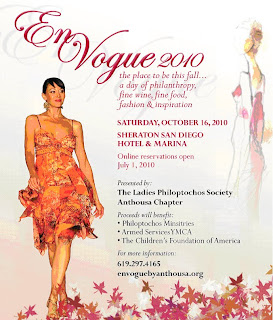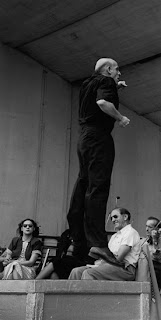
On Saturday, October 16, 2010, The Harbor Island Grand Foyer of the Sheraton San Diego Hotel & Marina will be transformed into a bazaar of hand-made, mouth-watering Greek sweets, one-of-a-kind finds, and cheerful entertainment. As guests are warmly welcomed to the reception at 11 a.m., the annual patron favorite, “Shopping by Chance”, will afford an opportunity for everyone to purchase chances on an arra
y of fabulous gift items, from dinners and hotel stays to jewelry, art, and much more.
Afterwards, Chef Steve Black will create a delicious EnVogue dining experience featuring a thoughtful green banquet menu, topped off with fair trade and shade grown coffee and imaginative desserts. A traditional runway fashion show of haute couture straight from New York will be presented by Lucinda of Couture Productions, featuring Don Caster of New York, Sue Wong, and custom knits by E. Saba.
A surprise local celebrity will preside over the inspiring ceremonies culminating in honoring the philanthropic contributions of four outstanding San Diegans chosen to receive the 2010 Anthousa Award, the chapter’s highest honor.
Proceeds will benefit:
Enhancing the lives of military personnel and their families in spirit, mind, and body.
The Children’s Foundation of America
Providing foster care for severely abused, neglected, and abandoned children.
Promoting charity, benevolence, and philanthropy in San Diego since 1938.
EnVogue is presented annually by the Ladies Philoptochos Society, Anthousa Chapter. The first Philoptochos (“fi-lop-to-hos”; friend of those in need) was organized in New York City in 1902. Today’s Philoptochos is a national non-profit organization officially chartered in 1931, comprised of approximately 480 chapters and 28,000 members. It is the largest Christian women’s charitable organization in the western hemisphere!
The Ladies Philoptochos Society, along with general chair Alexandra Mouzas, heartily invite you to join in the celebration on Saturday, October 16, 2010.
EnVogue deeply appreciates all of our contributors and our sponsors Konstantino, Carol Vassiliadis and Bradford Portraiture.
 Win the Zoe bracelet, a magnificent piece of art made of sterling silver and 18K gold, with citrine and peridot gemstones, by internationally famous designer Konstantino.
Win the Zoe bracelet, a magnificent piece of art made of sterling silver and 18K gold, with citrine and peridot gemstones, by internationally famous designer Konstantino.
Konstantino jewelry from Greece is known throughout the world for its unique designs and remarkable artisanship. All Konstantino adornments are still individually crafted in Athens and are created from sterling silver and 18 karat gold. Collections are inspired by the art, architecture, mythology, and people of Greece as fused through the creative genius of Konstantino Sioulas.

 The National Archaeological Museum is the largest museum in Greece and one of the world's great museums. Although its original purpose was to secure all the finds from the nineteenth century excavations in and around Athens, it gradually became the central National Archaeological Museum and was enriched with finds from all over Greece. Its abundant collections, with more than 20,000 exhibits, provide a panorama of Greek civilization from the beginnings of Prehistory to Late Antiquity.
The National Archaeological Museum is the largest museum in Greece and one of the world's great museums. Although its original purpose was to secure all the finds from the nineteenth century excavations in and around Athens, it gradually became the central National Archaeological Museum and was enriched with finds from all over Greece. Its abundant collections, with more than 20,000 exhibits, provide a panorama of Greek civilization from the beginnings of Prehistory to Late Antiquity.





 The Theatre of Homer is envisioned to be a campus of interrelated buildings, structures and gardens all to serve the purpose of introducing international visitors to Greece's greatest artist via stunning presentations of operas, plays, poetry, dance and research. All of the architecture will be in the compelling style of the great Bronze Age Palace of Knossos which looks at once modern and ancient. The whole cultural complex will be a very successful attraction for tourists from around the world. The Theatre of Homer campus will include the following elements:
The Theatre of Homer is envisioned to be a campus of interrelated buildings, structures and gardens all to serve the purpose of introducing international visitors to Greece's greatest artist via stunning presentations of operas, plays, poetry, dance and research. All of the architecture will be in the compelling style of the great Bronze Age Palace of Knossos which looks at once modern and ancient. The whole cultural complex will be a very successful attraction for tourists from around the world. The Theatre of Homer campus will include the following elements:


